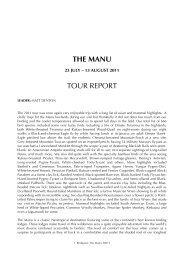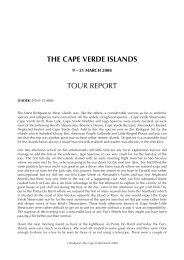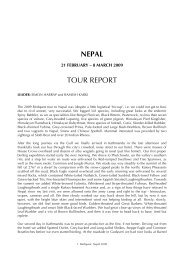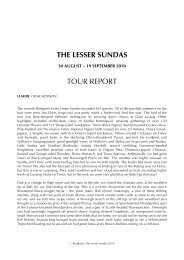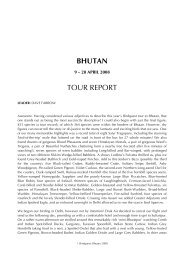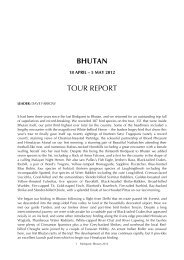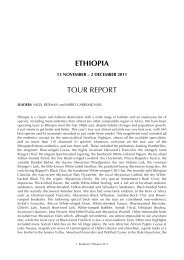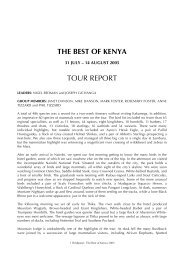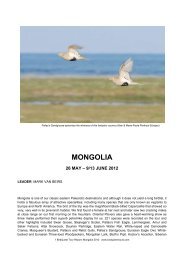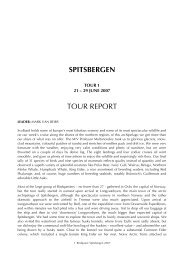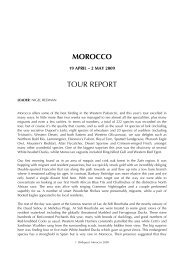Download Full Tour Report 3262kb - Birdquest
Download Full Tour Report 3262kb - Birdquest
Download Full Tour Report 3262kb - Birdquest
Create successful ePaper yourself
Turn your PDF publications into a flip-book with our unique Google optimized e-Paper software.
us, in the floating mat of vegetation, hundreds of Yellow-headed Blackbirds and Lined Seedeaters fed<br />
on the seeding grasses and then one by one we picked off most of the specialities. These included a<br />
number of Little and Spot-breasted Woodpeckers, a stunning male Green-throated Mango, several<br />
Lesser Horneros, Dark-breasted, numerous White-bellied and Red-and-white Spinetails, the abundant<br />
Spotted Tody-Flycatcher, several River Tyrannulets and a small group of Pearly-breasted Conebills.<br />
Meanwhile a number of Lesser Yellow-headed Vultures sailed ominously around us and Blackcollared<br />
and Savanna Hawks and a number of Snail Kites fed. We then headed to the western and<br />
more mature end the island, where the taller cecropias dominate the woodlands, in search of<br />
Castelnau’s Antshrike which we duly found. As the temperature rose and bird activity diminished we<br />
headed to the Igarape Janauari where, parked up in the flooded forest, we saw a number of lovely<br />
Capped Herons, a worried looking Green Ibis, a Slate-coloured Hawk, a few Short-tailed Parrots, a<br />
single Chestnut-capped Puffbird, a pair of Long-billed Woodcreepers and a pair of Zimmer’s<br />
Woodcreepers at point blank range together with a Striped Woodcreeper. After a pleasant lunch in<br />
the shade of the flooded forests we returned to Marchantaria to see more river island birds before<br />
heading back to Manaus.<br />
After our exploration of sites around Manaus it was time to move on to São Gabriel da Cachoeira, a<br />
frontier town located on the banks of the upper Rio Negro. Our flight from Manaus provided us with<br />
stunning views of both the Anavilhanas Archipelago and Pico Neblina. On arrival we headed out<br />
along the Strada Cucui in search of our first target; the Fiery Topaz. Once on site we had little time to<br />
wait before its harsh chattering calls gave away the presence of our bird and before long we were<br />
enjoying fantastic views of this dazzling species; bird of the trip for many. We also found Yellowtufted<br />
Woodpeckers, White-lored Euphonia, White-necked Jacobin, Great Antshrike and numerous<br />
Slender-footed Tyrannulets. Although there has been a lot of forest clearance adjacent to this road it<br />
still produces regular sightings of a number of important species in the area as we were to find out<br />
ourselves during a subsequent visit. We then headed to town for the first of several excellent meals at<br />
the Dona Iris restaurant on the beachfront. After a short break and lunch we visited the Abacaxi trail<br />
near town. This trail runs through a variety of white sand forests and scrubby campinas in a shaded<br />
tunnel of vegetation and we were to visit this trail on a number of occasions over the following days.<br />
Picking through the flocks we came across a pair of Amazonian Antshrikes and numerous Mousecoloured<br />
Antshrikes along with both Cinereous and Dusky-throated Antshrikes. These flock leaders<br />
gave away the presence of many other understorey species including White-flanked, Grey and Longwinged<br />
Antwrens, Ochre-bellied Flycatcher, White-crowned and Golden-headed Manakins, Wedgebilled<br />
and Olivaceous Woodcreepers and a number of others. Often in tow, interestingly enough,<br />
there are usually a good selection of canopy species that included, on this occasion, the range<br />
restricted Yellow-throated Antwren and equally localized Brown-headed Greenlet along with a pair<br />
of stunning Ringed Woodpeckers.<br />
On three of our days in São Gabriel we visited the west bank of the Rio Negro to work two excellent<br />
trails through extensive terra firma forests. Although birding in terra firma forests is not easy we did<br />
see an excellent selection of species. We spent two full days exploring the network of trails behind<br />
Snr Moises house and which is known as the Moises trail. We managed to see a great variety of birds<br />
that started with a pair of Yellow-browed Antbirds, a Spot-backed Antbird and a pair of Dusky<br />
Antbirds. Walking into the forests we found Cobalt-winged Parakeets and Orange-cheeked Parrots as<br />
well as brief views of a Tiny Hawk and then it began to rain. We retreated to Snr Moises house for<br />
the remainder of the morning and an early lunch. After lunch we found a Chestnut-capped Puffbird<br />
sat soaked on a branch while a Lesser Seedfinch sang. We then headed back out again onto the trails<br />
to find a small flock of Maroon-tailed Parakeets, several Straight-billed Hermits at a large lek along<br />
the trail followed by a number of Reddish Hermits a little further on. The trail runs through a small<br />
area of tall campina where Grey-bellied Antbird was found a week before holding territory but in<br />
spite of searching we failed to find it. However, we did find a pair of White-necked Puffbirds and a<br />
single Yellow-billed Jacamar lurking in the undergrowth. We had great views of Amazonian Barred<br />
and Ocellated Woodcreepers, several Fasciated Antshrikes, Stipple-throated and Rufous-tailed<br />
4 <strong>Birdquest</strong>: Amazonian Brazil 2011




